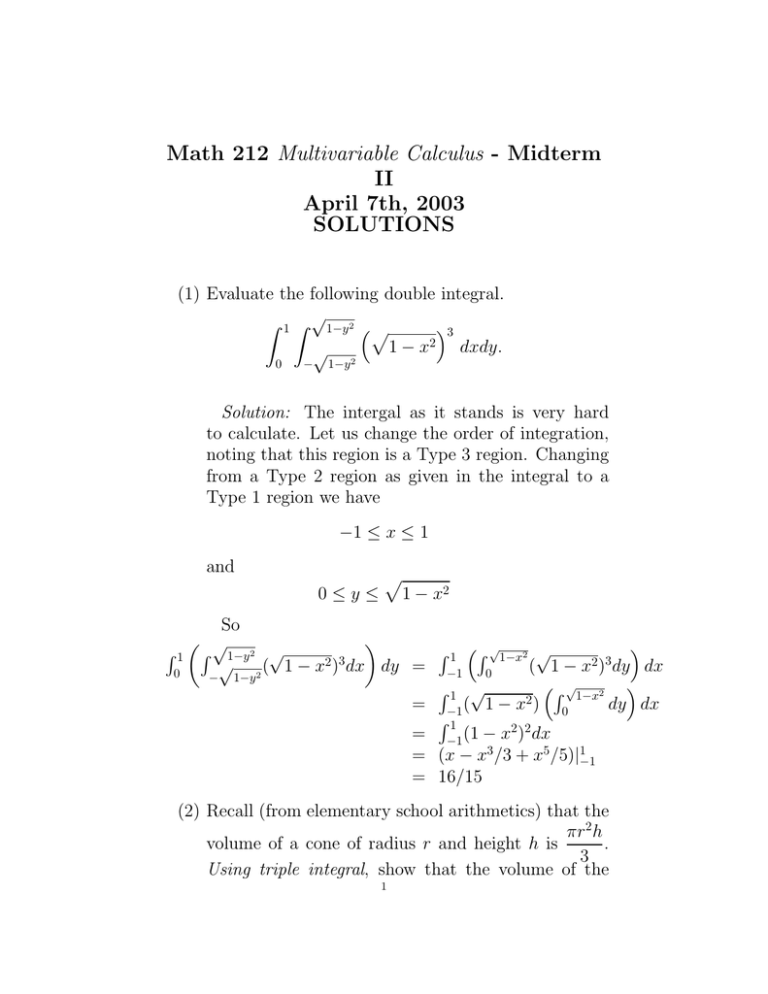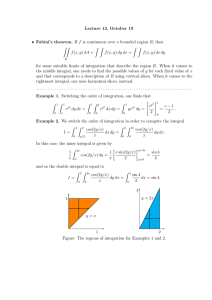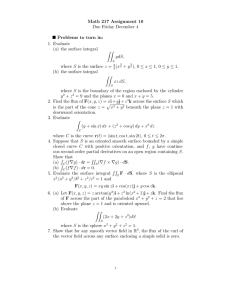Math 212 Multivariable Calculus - Midterm II April 7th, 2003 SOLUTIONS
advertisement

Math 212 Multivariable Calculus - Midterm II April 7th, 2003 SOLUTIONS (1) Evaluate the following double integral. Z 1 Z √1−y2 p 3 2 1−x dxdy. √ 0 − 1−y 2 Solution: The intergal as it stands is very hard to calculate. Let us change the order of integration, noting that this region is a Type 3 region. Changing from a Type 2 region as given in the integral to a Type 1 region we have −1 ≤ x ≤ 1 and 0≤y≤ p 1 − x2 So √ R 1 R √1−x2 √ R 1 R 1−y2 √ 3 3 2 2 √ ( 1 − x ) dx dy = −1 0 ( 1 − x ) dy dx 0 − 1−y 2 R √ 2 R1 √ 1−x 2 = −1 ( 1 − x ) 0 dy dx R1 = −1 (1 − x2 )2 dx = (x − x3 /3 + x5 /5)|1−1 = 16/15 (2) Recall (from elementary school arithmetics) that the πr2 h volume of a cone of radius r and height h is . 3 Using triple integral, show that the volume of the 1 2 8π . (Hint : Triple 3 integral of 1 over W is the volume of W .) cone of radius 2 and height 2 is Solution: Express the cone in cylindrical coordinates: it is all points (r, θ, z) where 0 ≤ θ ≤ 2π 0≤z≤2 0≤r ≤2−z Then the required volume is: R 2π R 2 R 2−z R 2π R 2 2 dr dz dθ = 0 (2 − z) /2dz dθ 0 0 0 R02π = (4/3) 0 dθ = 8π 3 (3) Let P be the parallelogram in the xy-plane spanned by the two vectors (1, 2) and (1, 1) (based at the origin). Evaluate the following double integral. Z Z 2x2 − 3xy + y 2 dA. P Solution: Let us change coordinates. We will find a one-to-one onto linear map from [0, 1] × [0, 1] to the parallelogram P . Suppose this map is a b u T (u, v) = = (au + bv, cu + dv) c d v We will choose T (1, 0) = (1, 1) and T (0, 1) = (1, 2). With this choice, solving for a, b, c and d we get a = 1, b = 1, c = 1 and d = 2 i.e. the map is 1 1 u = (u + v, u + 2v) T (u, v) = 1 2 v 3 So the coordinate functions are x(u, v) = u + v and y(u, v) = u + 2v Calculating, ∂(x, y) 1 1 = ∂(u, v) 1 2 Then: RR 2 2 P (2x − 3xy + y )dA R 1 R 1 2 2 = 0 0 (2(u + v) − 3(u + v)(u + 2v) + (u + 2v) )du dv R 1 R 1 = 0 0 (−uv)du dv = −1/4 (4) Let W be the region in the second quadrant (x ≤ 0, y ≥ 0) bounded by z = 1 and z = xR2 R+ Ry 2 . Use cylindrical coordinate system to evaluate W x dV. Solution: In cylindrical coordinates the region over which we are integrating is given by: 0≤r≤1 π/2 ≤ θ ≤ π r2 ≤ z ≤ 1 Thus RRR R 1 R π R 1 0 π/2 r2 (r cos θ)rdz dθ dr W xdV = R R1 2 π 2 = 0 r (1 − r ) π/2 cos θdθ dr R = − 01 r2 (1 − r2 )dr = −2/15 4 (5) Let c be the helix c(t) = (cos t, sin t, t), 0 ≤ t ≤ π/2. Let f (x, y, z) = xy. Evaluate the following integral. Z f ds. c Solution: Calculate c0 (t) = (− sin t, cos t, 1) and so p √ 2 2 ||c (t)|| = (− sin t) + (cos t) + 1 = 2 0 Thus √ R R π/2 2)dt f ds = (cos t)(sin t)( c 0 (use substitution u = sin t) √ R1 = √2 0 udu = 2/2 (6) (a) Let c be the path defined by c(t) = (cos3 t, sin3 t, sin 2t ), 0 ≤ t ≤ π. Evaluate the following line integral. Z F · ds c where F(x, y, z) = (2xyz, x2 z, x2 y). Solution: If we do this integral directly it becomes very hard. But we notice that F(x, y, z) = ∇f (x, y, z) where f (x, y, z) = x2 yz So we calculate R R F · ds = c (∇f ) · ds c = f (c(π)) − f (c(0)) = 0−0 = 0 5 (b) Let c be the cuspidal curve c(t) = (t2 , t3 ), −1 ≤ t ≤ 1. Evaluate the following integral. Z xy dx + x2 dy. c R Solution: Calculate R1 2 3 2 xydx + x dy = (t )(t )(2t) + (t4 )(3t2 )dt c R−1 1 = −1 5t6 dt = 10/7





